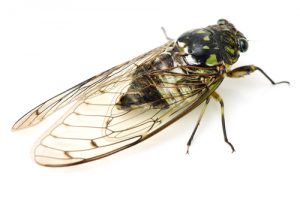Cicadas Are Making Their Appearance!
By Chris Williams on July 28, 2011.
Q. Do we have periodical cicadas in our area? When can we expect to see them?
A. We do have some broods of 17-year periodical cicadas in parts of the Northeast but not nearly in the numbers usually seen in the Midwest and farther south. We have no periodical cicada emergences this year though, and in fact, our next emergence isn’t until 2018. Before you say, “but I’ve seen cicadas this summer!” let me explain. What we see every summer is the annual cicada, not the periodical cicada.
Periodical cicadas are wonderful, amazing creatures because the nymphs spend 17 (or 13) years feeding on roots underground before they make their appearance as adult cicadas. The annual cicadas have a similar (but much shorter) life cycle and we have some annual cicadas emerging every summer. They’re easy to tell apart. Periodical cicadas are black with red eyes and orange legs, and clear wings. Annual cicadas are bigger than the periodicals and greenish in color with black markings.
Annual cicadas make their appearance in mid to late summer, just when the weather gets really hot. That’s why they’re sometimes called “dog day cicadas.” Everyone recognizes the high-pitched buzzing sound they make in the treetops. When the underground nymphs are ready to emerge, they burrow to the surface (leaving pencil-sized holes), climb onto tree trunks or other surfaces, split their nymphal skins and emerge as winged, adult cicadas. Kids love to collect the crunchy brown skins left behind.
 In the U.S., there are actually 15 different 17-year broods of the periodical cicada (though some of them are almost “extinct”) and several 13-year broods. Each brood or hatch is given an identifying Roman numeral. Most of the broods are separated geographically, but some overlap. Most years, at least one of the broods emerges somewhere in the U.S., east of the Mississippi. When a periodical brood emerges, it usually does so in huge numbers that can’t be ignored! Maybe you’ve been lucky enough to witness a periodical cicada brood’s emergence somewhere.
In the U.S., there are actually 15 different 17-year broods of the periodical cicada (though some of them are almost “extinct”) and several 13-year broods. Each brood or hatch is given an identifying Roman numeral. Most of the broods are separated geographically, but some overlap. Most years, at least one of the broods emerges somewhere in the U.S., east of the Mississippi. When a periodical brood emerges, it usually does so in huge numbers that can’t be ignored! Maybe you’ve been lucky enough to witness a periodical cicada brood’s emergence somewhere.
In the Northeast, we have Brood VII in upstate New York; next emergence 2018. Brood X is also known as the Great Eastern Brood and emerges in large areas of the eastern U.S., next in 2021. It gets as far north as Long Island. Brood XIV emerged in New York and Massachusetts in 2008; next emergence 2025. In the meantime, you’ll have to enjoy our annual cicadas.
Cicadas don’t bite or sting and neither the nymphs nor adults cause any feeding damage to plants. When a large periodical brood emerges, however, egg-laying in branches can cause some tips to die. The best thing to do about cicadas is to marvel at them and enjoy these dinosaurs of the insect world. They live far longer than any other insect. They provide food for birds and other animals and they will be gone in just a few weeks.